A Reminder About the Corrales Garden Tour Next Weekend
SUNDAY, JUNE 5, 2016

2016 Corrales Garden Tour
SUNDAY, JUNE 5, 2016

2016 Corrales Garden Tour
Dr Huey, know best among most rosarians as a common root-stock for grafted roses such as hybrid teas, floribundas, and many other classes of roses, may be seen in all of its own glory all over the Village of Corrales, New Mexico, for approximately one week in May. The Corrales Rose Society held its 3rd Annual Dr Huey Tour on May 15 this year, and the blooms were truly at their peak; the best overall I have ever seen them.
You may wonder why Corrales has so many of this hybrid wichurana, not usually planted for its own good qualities. Corrales sits on the river, here in the Middle Rio Grande Valley. You may recall from elementary school that “hot air rises, cold air sinks.” When I’m visiting friends in Corrales, even in the summer, if I am going to be there in the evening, I always take a jacket. Winter nights can get 10°-15°F colder than my location in Albuquerque. Corrales could be considered a “cold sink” and is just another example of one of many micro environments in the high desert.
People buy and plant grafted roses, and enjoy them as such while they are in that form. But many winters have killing freezes, often prolonged. In a desert area where winterizing of roses is rarely, if ever done, the grafted portion dies. In spring, the very hardy, alkaline-soil-thriving root-stock appears. The blooms are not at all unattractive, as you will see. People in the high desert tend to appreciate what grows and thrives, and most of these are kept. Some people keep them trimmed; some allow them to grown into their natural fountain shape; many allow them to cascade beautifully over walls; and one in particular has gotten quite huge!!!
I hope you enjoy these images as much as I enjoyed seeing the roses in person.
The 2016 Corrales Garden Tour is coming up very soon, Sunday, June 5. The information for times, as well as for pre-sale and day of tour sale are on this poster.

2016 Corrales Garden Tour
Gardens Fulfill Needs
Gardens answer so many desires. They are places of beauty, offering emotional and physical recharging and introspection, or a chance to share hospitality. Our gardens are the first place to act locally as we think globally about caring for the environment.
The six unique gardens on the Corrales Garden Tour on June 5, from 9AM-4PM, speak to all those needs and yearnings. Some are quietly serene and very private, others capture rain runoff and allow it to return to the soil; some have whimsical elements and a variety of seating areas. You will see gardens in the trees, others in the sandhills, and each has taken our climate and need for water conservation to heart in various ways.
Different gardens are featured each year, and the gardens are always interesting. Here is a post from last year’s tour on water features in the garden.
Six different gardens will be featured this year, and Master Gardeners will be available to answer questions. It will be a very enjoyable day.
Be sure to wear sunscreen, and it is always a good idea to have water with you.
Cosmos this past Labor Day weekend were spectacular in the Corrales garden of our friends Tim and Laurie. They grow many different plants, with roses being the focal point of the formal part of the garden. But, sunflowers, brown-eyed Susan, echinacea, morning glories, coreopsis, and others, have been allowed to naturalize portions of their land along the Rio Grande. All were spectacular this past weekend.
Cosmos attract many different pollinators as well as hummingbirds, goldfinches, and other birds and butterflies. The entire garden was buzzing with lively critters.
There were so many different colors and combinations in these naturalized, self reseeding annuals . This is a small sample to give a feel for the beauty of even just one kind of flower in the garden.
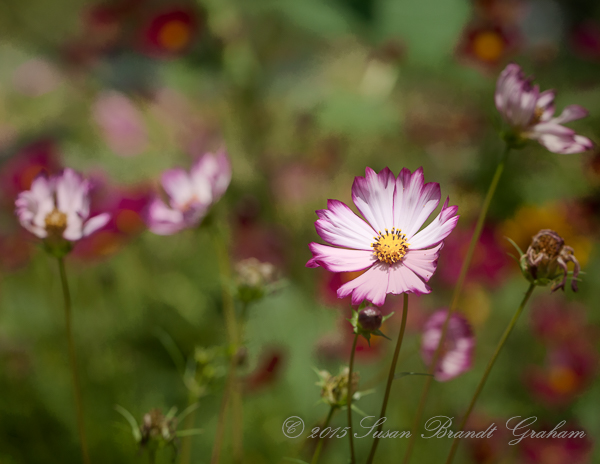
Field of Cosmos
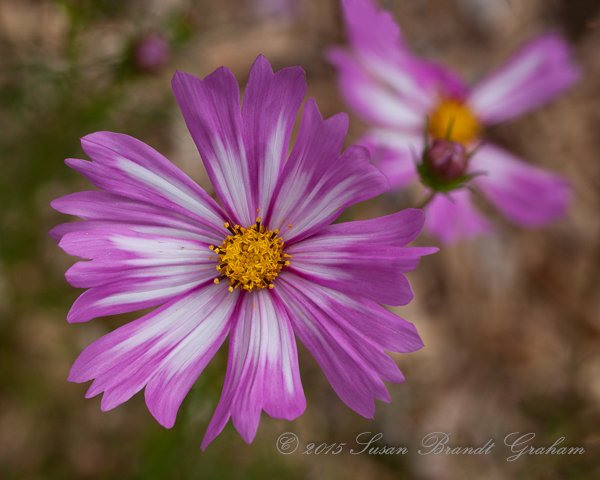
Cosmos, Up Close
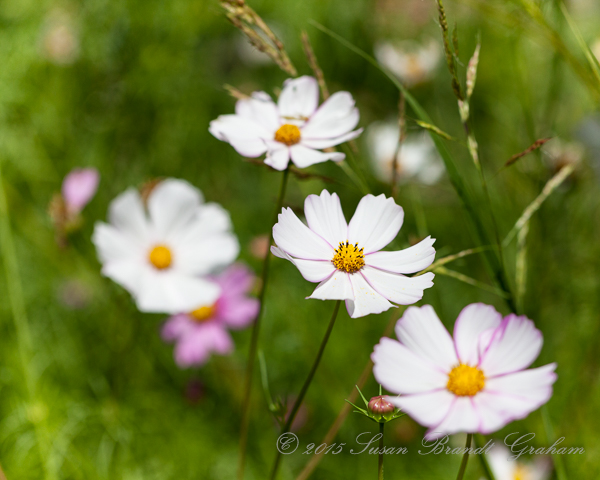
Almost White Cosmos
This is just a very small sample of the cosmos in the landscape. They appear among a wide variety of flowers allowed to naturalize the garden space, which was spectacular in its color and beauty this past weekend.
The prolonged drought has taken its toll among many flowers. One very good adaptation to that appears to be growing a wide variety of plants. More images of different flowers growing in this beautiful space will appear later in different posts.
Green June bug: although quite common here in the summer, I had never really looked at one until I caught a glimpse of something metallic blue as I took the garbage to the curb for pickup the next day. At first glance I thought maybe it was one of the metallic blue cutter bees I have seen here on roses in early spring. I got my camera, moved the dead insect out of crack in the sidewalk, and proceeded to photograph it. I had to get down on the ground to do it, and I just ignored the people who slowed down driving by who wondered what this woman was doing on the driveway.
It wasn’t until I turned it over that I realized it was a very common green June bug, a type of scarab beetle. The back view is not particularly impressive:
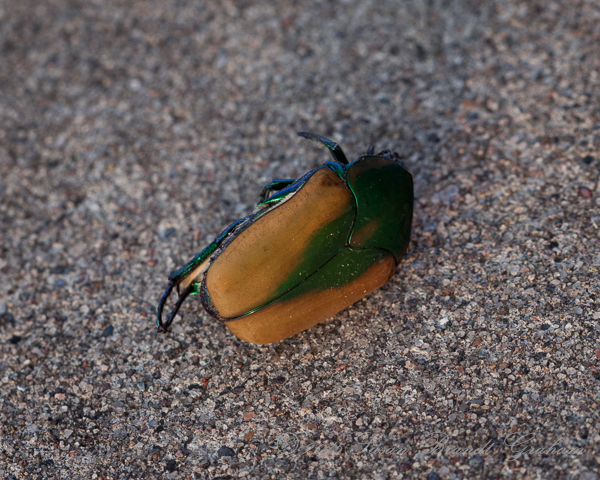
Green June Bug, a scarab beetle
I had seen that view many times. It was the complexity and beauty of the underside that I had never seen before.
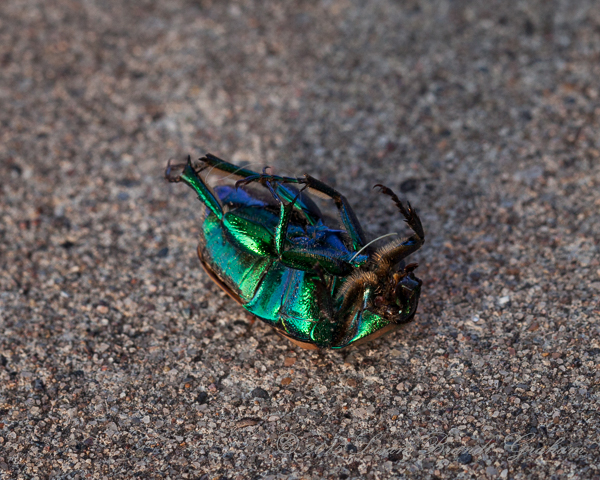
Underside, Green June Bug
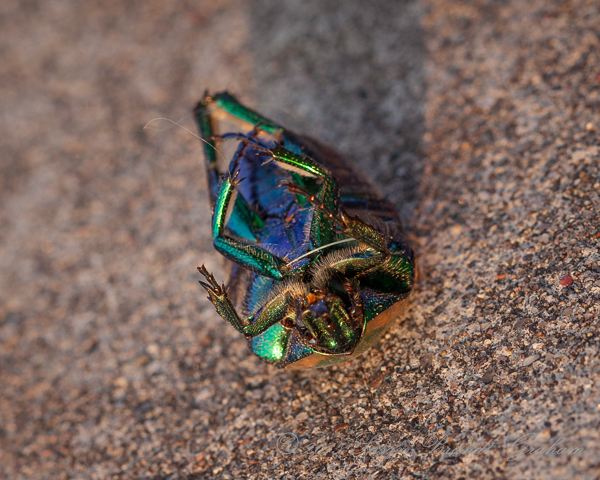
Green June Bug: Beautiful in Its Complexity. “Facial” View, the Eyes Were Missing
Garden takeaway: green June bugs do not harm the garden.
Photography takeaway: you don’t always have to go looking for things to photograph; sometimes they just appear when people keep their eyes open. 🙂
Update: There are two species of Green June Bugs. The one that occurs in the West, from Texas to California (including New Mexico) may also be referred to as the Fig Beetle of Figeater Beetle. More info here. Thanks, Tim.
Green Rose really is a rose. It is a sport, or a mutation, made up of sepals. Its official American Rose Society color is “white,” something of a trick question on some of the practical exams to become an ARS Accredited Horticulture Judge. I have never seen this white part, but it doesn’t matter. I enjoy having this rose in my garden.
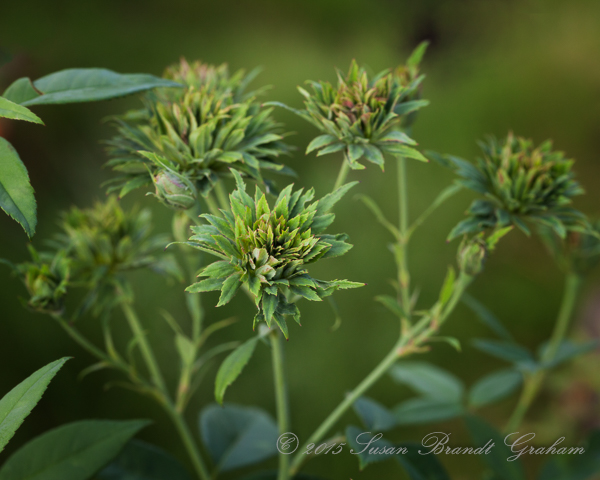
Green Rose, a China rose, discovery in US dated circa 1827
Not only is it interesting just to look at, but rose arrangers find it useful as line material in rose arrangements.
In a previous post I mentioned the discussion among friends regarding editing of images, and the use of jpg versus raw files. Here I would like to briefly mention composition. Rule of Thirds can be a very useful composition guideline in floral photography. Those of you who read here frequently know that it is a guideline I use in a wide variety of my photography. When photographing rose sprays, however, my personal preference for my own photography is symmetry and balance. I like to show the structure of the spray, and tend to photograph sprays from that perspective, rather than from the top down. To my eye, symmetry and balance is a good way to show both the structure and beauty of rose sprays, at least in many instances. This image of the Green Rose uses symmetry and balance.
Another example is my image of Dream Weaver:
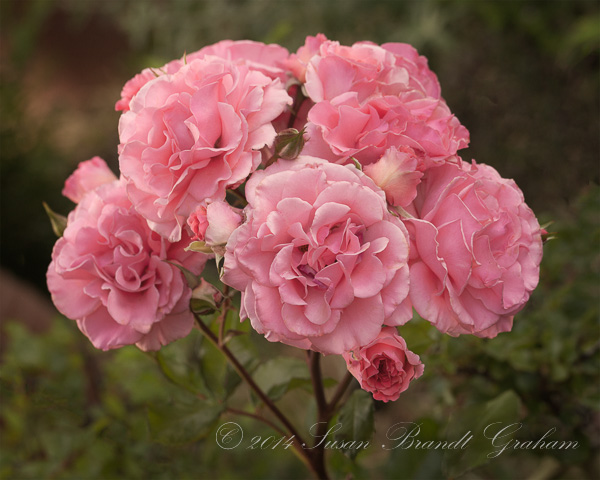
Spray of rose, ‘Dream Weaver.’ Image awarded ‘Queen’ (Photography) at the ARS Fall 2014 National Convention.
Green Rose, one of the unique roses in the roses in the rose world.
Happy World Photography Day! #worldphotoday
This beautiful spider and its equally beautiful web greeted me one recent morning. The web had been woven overnight, and blocked my way from the patio to the remainder of the yard. Oh, well… I went in to get my camera, and then walked through the round garden to get to the other side, where the light was better for a photograph.
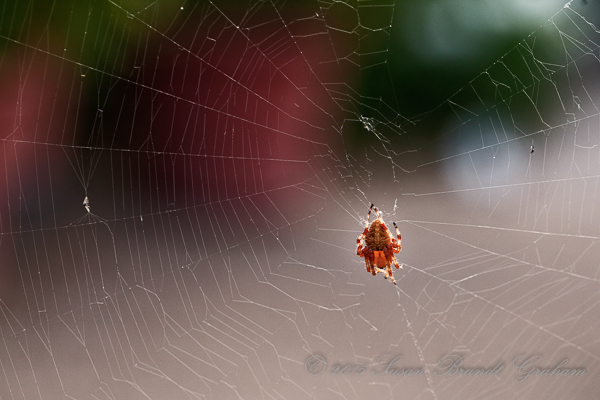
Beautiful spider and web
Close up view:
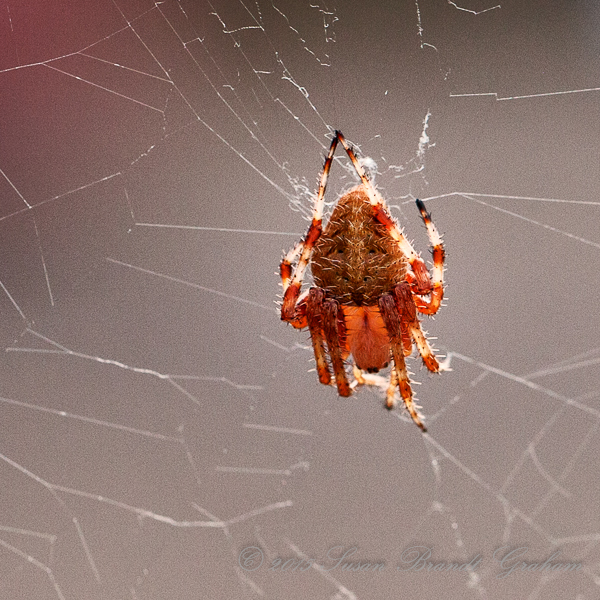
Beautiful spider and web, up close
Spiders of a wide variety are found in the gardens of the Desert Southwest. Here in Albuquerque, I expect to find beautiful webs such as this one, some stronger, some less strong, from August until a heavy frost. They may occur at other times, but this is the time I expect to see them. At times, I have had access to the front door blocked by a beautiful web I did not wish to destroy. This was the first web I have had that blocked usual access from the patio to the rest of the yard. Although I would have preferred its location to be elsewhere, I was happy to find such a beautiful web in the morning light.
The Sphinx Moth is one part of a life cycle that gives rise to what is known casually as a “tomato horn worm” (not a worm at all). But the critter referred to as such can destroy not only tomatoes, but other plants such as datura, in a very short period of time. The moth phase is the beautiful portion of that life cycle, IMHO (some entomologists might disagree 😉 ).
Recently, as I was picking some cherry tomatoes, I thought to myself how wonderful this year was in that I had not seen destructive activity on my tomatoes, pepper, or datura. Walking into the house with my harvest, what did I see? A sphinx moth! The moth is quite attractive, but spells trouble down the road for my tomatoes.
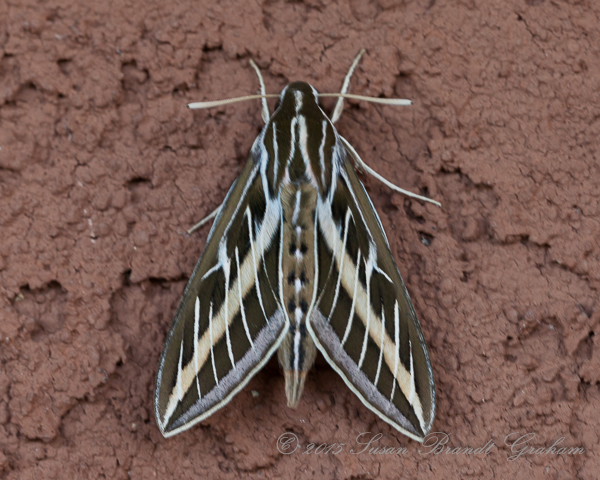
Sphinx Moth
Of course, I had to photograph it. But, as I did, I noticed a very tiny moth on the stucco as well.
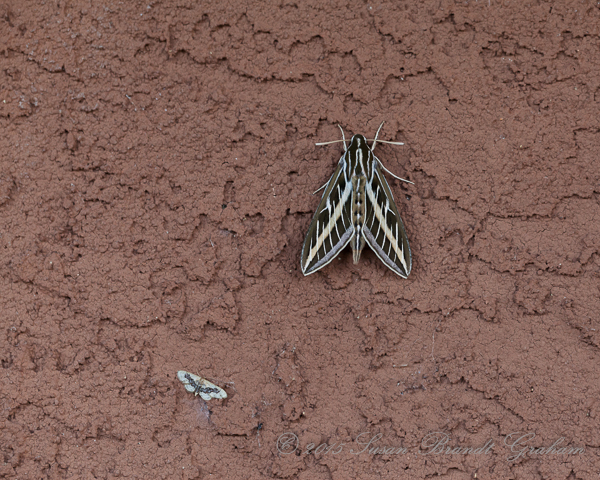
Sphinx moth and another tiny moth
Time to get up close and personal.
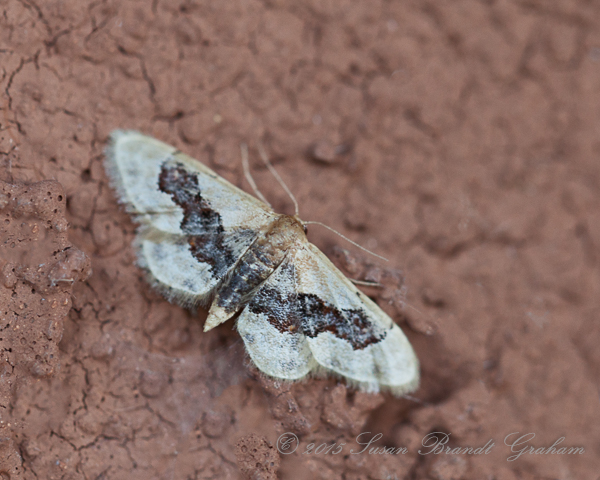
Very small moth
I do not know the name of this small moth. I think its pattern is quite attractive, although not as complex as the sphinx moth.
The appearance of the sphinx moth has officially put me on notice to carefully watch the tomato, pepper, and datura for the appearance of the destructive “hornworms.” The beauty of the moth phase, however, cannot be denied.
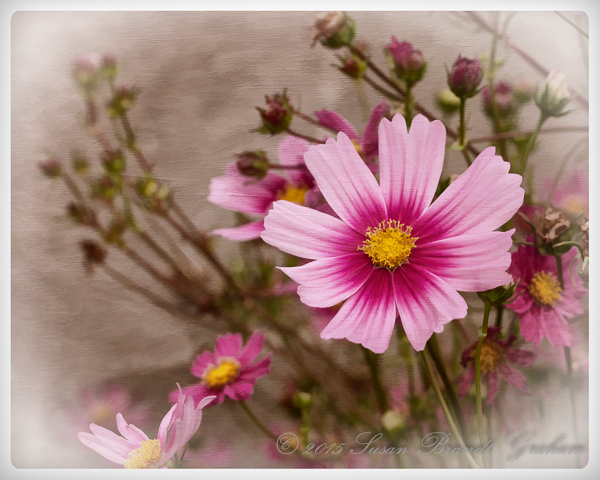
Cosmos
Cosmos is an annual I grow every year, not only for the beauty of the flowers, but also because the goldfinches and hummingbirds like them. When the seeds develop, the goldfinches prefer them to the nyger seeds I usually provide. For that reason, I do not deadhead these flowers, even though I would get more blooms if I did. I grow them, enjoy them, and then enjoy watching the birds feed on them.
Several days ago I posted some images from my garden, images with no editing (to say nothing of enhancements!) except for cropping and placement of a watermark. That was something of a photography exercise for me. Although I was not unhappy with the outcome, I personally found the exercise itself to lack the “fun” I find in digital photography. Last evening, for the first time in some time, I had a couple of hours to do what I enjoy – manipulate a photograph to create an image that reflected something more (to me, at least) than “a real flower captured by the camera.” What you see is the result.
I firmly believe that developing a raw file is something absolutely necessary to realize the full potential of digital photography, and should always be allowed.
“Enhancing” a photo through the use of many techniques, as this image has been enhanced, is very different from editing a raw file to develop it. I think any discussion of what should be allowed for any given use of an image should clearly distinguish between “editing” to develop a raw file, and “enhancing” to create an image not captured on a sensor.
Back to cosmos – a wonderful annual for its inherent beauty, and as a natural “feeder” for birds. A good flower for the garden in the desert southwest.
Photo challenge to myself – go photograph some things you frequently photograph, the way you frequently photograph them. But, use only the jpg, with no editing other than cropping and applying a copyright watermark.
Recently some photographer friends and I had one of the very common discussions floating around since the advent of digital photography. Is editing a raw file (digital negative) kind of “cheating,” or absolutely necessary to realize the full potential of digital photography? Anyone who knows me at all knows that developing my own raw files is something I do as part of my standard workflow, and overall will continue to do. It is one of the things I really love about digital photography!
The discussion with friends, however, made me want to go out and see what I would get with jpg rather than raw files, with the only editing being cropping to an 8×10 ratio rather than an 8×12 ratio, and the application of a watermark.
These are the results.
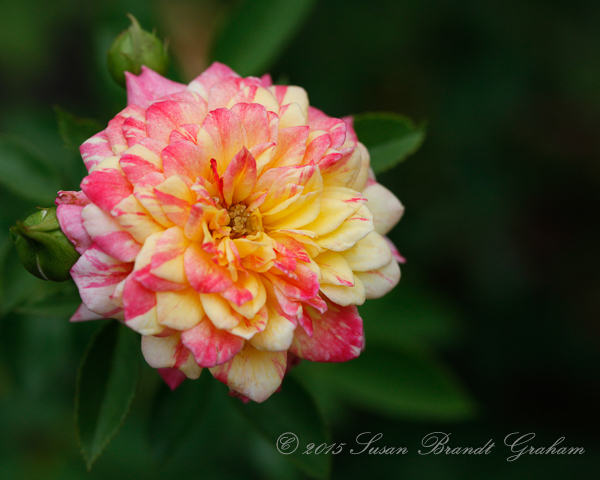
Miniature rose, ‘Climbing Earthquake’
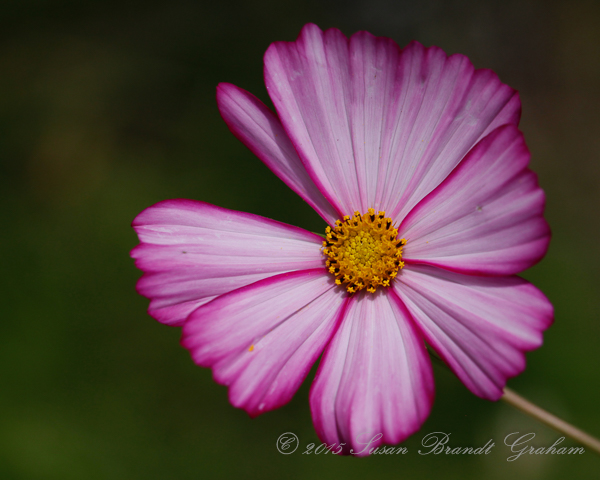
Cosmos, with “imperfect beauty”
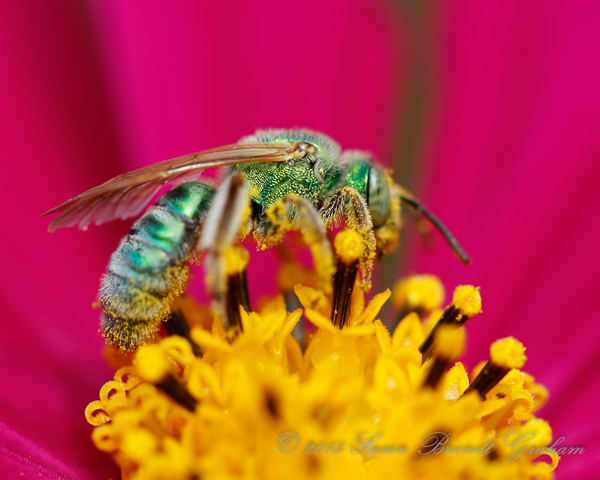
Green bee with pollen, on cosmos
The challenge to myself was a fun exercise, but I am a confirmed “photograph in raw” person, just because I truly enjoy the editing process.
LightStalking has a good discussion of the benefits of using raw files rather than jpgs.